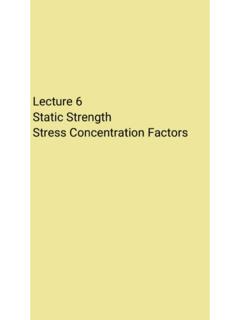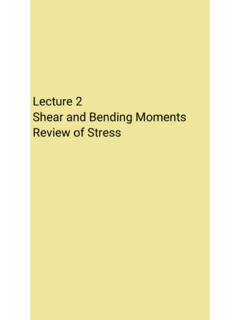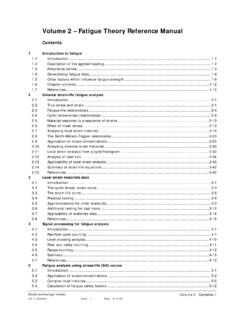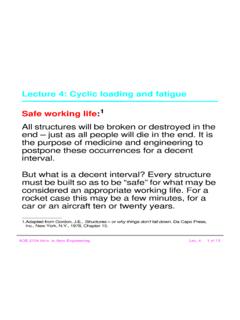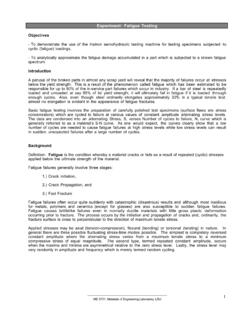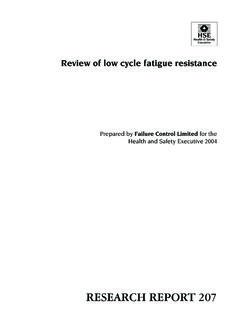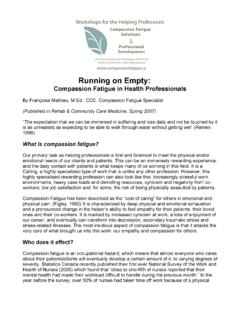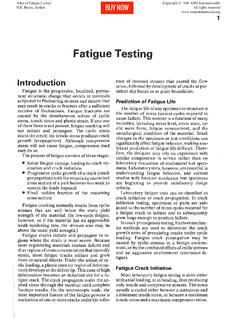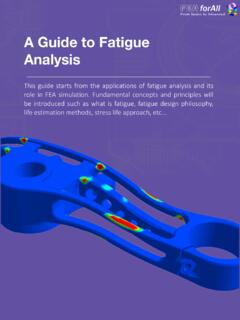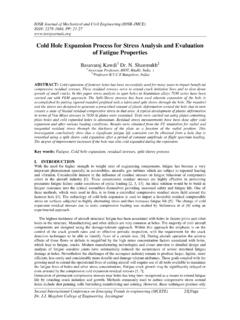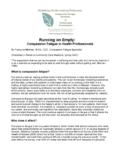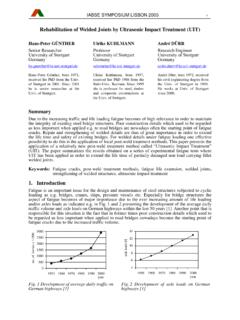Transcription of Fatigue Analysis - UTEP
1 stress - life ApproachFor Extreme EnvironmentsFatigue AnalysisStress- life ApproachPresented by Calvin M. Stewart, PhDMECH 5390-6390 Spring 2021 Outline Fatigue Loading stress - life Approach Unmodified Endurance Limit Endurance Limit Modifiers Mean stress Solving ProblemsFatigue LoadingFatigue Loading Components, structures, and vehicles are subjected to quite diverse load histories. Some load histories may be simple and repetitive. Others may be completely random. The randomness may contain substantial portions of more deterministic loading. For example, the ground-air-ground cycle of an aircraft has substantial similarity from flight to LoadingGround-Air-Ground Cycle of AirCraftRepetitiveRandomnessFatigue LoadingOffshore StructuresAircraftEnvironmental EffectsFatigue LoadingTypical Load Histories From Actual Ground Vehicle ComponentsFatigue LoadingA Typical Load History of Short-Span BridgeFatigue Loading These load histories are typical of those found in real- life engineering situations.
2 Fatigue from variable amplitude is discussed in Chapter 9. Constant amplitude loading is introduced in this chapter. Constant amplitude loading is used: To obtain material Fatigue behavior/properties for use in Fatigue design, Some real- life load histories can occasionally be modeled as essentially constant Fluctuating StressPulsating TensionCompletely Reversed (S-NCurve)Fig. 6 23 Fluctuating stress with high frequency ripplesNonsinusoidalfluctuating stressNonsinusoidalfluctuating stressLaboratoryReal WorldShigley sMechanical DesignFatigue LoadingShigley sMechanical DesignFatigue Loading Def s: stress range stress amplitude Mean stress stress ratio, R Amplitude ratio, Amaxmin2a =maxmin2m +=maxminr = = minmaxR =maA = PeriodFrequency1f =1f =Shigley sMechanical DesignFatigue Loading Fully Reversed: R = -1; A = Zero to Tension: R = 0; A = 1 Zero to Compression: R =.
3 A = -1 R A A R11 ARA =+11 RAR =+R = -1R = 0 Shigley sMechanical DesignFatigue Loading R= -1 and R= 0 are two common reference test conditions used for obtaining Fatigue properties. R= -1 is called the fully reversed condition since Smin= -Smax R = 0, where Smin= 0, is called pulsating tension. One cycle is the smallest segment of the stress versus time history which is repeated periodically. Under variable amplitude loading, the definition of one cycle is not clear and hence reversals of stress are often considered. In constant amplitude loading, one cycle equals two ApproachStress- life Approach: (S-N) The stress - life , S-N, method was the first approach used to understand and quantify metal Fatigue .
4 It was the standard Fatigue design method for almost 100 years. The S-N approach is still widely used in design applications where the applied stress is primarily within the elastic range of the material and the resultant lives (cycles to failure) are long, such as power transmission shaft. The stress - life method does not work well in low-cycle Fatigue , where the applied strain have a significant plastic component. In low-cycle Fatigue the Strain- life method is more Approach: Typical CurveStress- life Approach Typical schematic S-N curve obtained under axial load or stress control test conditions with smooth specimens.
5 Constant amplitude S-N curves of this type are plotted on semi-log or log-log coordinates. S-N curves obtained under torsion or bending load-control test conditions often do not have data at the shorter Fatigue lives (say 10^3 or 10^4 cycles and less) due to significant plastic deformation. Torsion and bending stress equations =T r / J and = M y /I can only be used for nominal elastic Approach: Variability Typical variability with less variability at shorter lives and greater variability at longer lives. Variability in life for a given stress level can range from less than a factor of two to more than an order of magnitude.
6 Variability and statistical aspects of Fatigue data are discussed in Ch. Approach: Endurance Limit Fig. (a) shows a continuous sloping curve, while Fig. (b) shows a discontinuity or knee in the S-N curve which indicates an endurance limit. This endurance limit has been found in only a few materials ( low and medium strength steels) between 10^6 and 10^7 cycles in non-corrosive conditions. Most materials do not contain the endurance limit even under controlled environments. Under corrosive environments all S-N data have a continuous sloping curve. When sufficient data are available, S-N curves are usually drawn through median points and thus represent 50 percent expected for Steel in Laboratory Air()010 ,utSEndurance LimitShigley sMechanical DesignS-NDiagram for Steel in Laboratory Air()010 ,utSEndurance LimitFinite LifeInfinite LifeLow Cycle Fatigue (LCF)High Cycle FatigueShigley sMechanical DesignStress- life Approach.
7 Definitions Definitions Cycles to Failure, Nf the number of cycles a material (or a component) can resistance Fatigue failure connoted by Fatigue life Fatigue Strength, Sf the value of fully reversed alternating stress , athat corresponds to a particular number of Nf Endurance/ Fatigue Limit, Se a stress level below which a material can be said to have infinite life Low Cycle Fatigue (LCF) -when Nfis in the range of 100to 103. High Cycle Fatigue (HCF) -when the number of Cycles to failure, Nf, is in the range of 103to 106. Infinite life -when Nfis equal to or greater than Approach: FCG Physically, Fatigue crack growth (FCG) typically consists of crack nucleation, growth, and final fracture.
8 The stress - life Approach measures Total life and cannot distinguish the individual stages of FCG. When tracking crack length is important, the LEFM approach should be Approach: Basquin sEquation Basquinin 1910 suggest a log-log straight line S-N relationshipBATri-Slope ModelBasquinModel()BffSAN=Note: the Tri-Slope Model can be used when a distinct bend in observed at the transition point between the LCF and HCF regimes. BasquinEquationuAS=()()1 6 logeuBSS=How to Find A& BConstantsShigley sMechanical DesignStress- life Approach The S-Ndiagram is applicable for completely reversed stresses (R=-1) only! We must use Fatigue Failure Criterion to correct for mean stresses!
9 Assumptions: High cycle Fatigue regime Strain range is dominated by elastic rather than plastic strain Peak and valley stresses are constant Only one component of loading ( , axial, torsional, bending) acting at a time stress amplitude is plotted against cycles to failure ( S-N diagram)Unmodified Endurance LimitThe Endurance Limit, Se Def: Endurance limit, Sethe stress below which a material can be consider to have infinite life . The material can be subject to an infinite number of cycles without Fatigue LIFEThe Endurance Limit, Se For a given material the endurance/ Fatigue limit has an enormous range depending on: surface finish, size, type of loading, Cyclic rate (frequency), temperature, corrosive, and other aggressive environments, mean stresses, residual stresses, and stress Endurance Limit, S e The unmodified Endurance limit, S eis measured in stress amplitude, aunder completely reverse stress (R=-1) with small highly polished unnotched specimensbased on 106to 5x108cycles to failure in laboratory air environment.
10 Can range from essentially 1 to 70 percent of the ultimate tensile strength. Example of 1 percent of Suis a high strength steel with a sharp notch subjected to a high mean tensile stress in a very corrosive atmosphere. Example of 70 percent of Suis a medium strength steel in an inert atmosphere containing appreciable compressive residual Specimen Test specimens are subjected to repeated stress while counting cycles to failure Most common test machine is R. R. Moore high-speed rotating-beam machine Subjects specimen to pure bending with no transverse shear As specimen rotates, stress fluctuates between equal magnitudes of tension and compression, known as completely reversed stress cycling Specimen is carefully machined and polishedFig.

